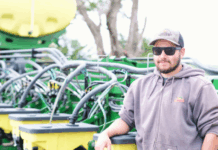From the Office of Public Affairs | http://www.news.ku.edu
Headlines
New book explores how contemporary Iranian artists sidestep line of repression
LAWRENCE — In the Islamic Republic of Iran today you can be a well-paid entertainer making escapist fare. But those aren’t the artists Rana Esfandiary is interested in. In her new book, “At the Threshold: Contemporary Theatre, Art, and Music of Iran,” the assistant professor of theatre & dance at the University of Kansas writes about the daring stage directors, probing photographers and electronic musicians who are pushing against mullah-imposed boundaries
KU faculty to host discussion: ‘The Deepening Crisis in Israel/Palestine’
LAWRENCE — A panel of University of Kansas professors will present “The Deepening Crisis in Israel/Palestine: History. Context. Human Rights.” to discuss the escalating conflict in the region. The event will take place from 4 to 6 p.m. Oct. 18 in the Malott Room of the Kansas Union.
School of Engineering researcher to give distinguished professor lecture on signal processing
LAWRENCE — Shannon Blunt’s expertise in radar and remote sensing is internationally recognized, and he has made notable contributions that have been used in operational radar and sonar systems. The Roy A. Roberts Distinguished Professor of Electrical Engineering & Computer Science at the University of Kansas will present his inaugural distinguished professor lecture, “Embracing Uncertainty to Enable Physically Meaningful Signal Processing,” at 5:30 p.m. Oct. 26 in the Beren Petroleum Conference Center in Slawson Hall. Individuals can register to attend the lecture and reception.
Study examines role of working memory, cognitive functions in English learners learning to write
LAWRENCE — When a person attempts to express their thoughts in writing, they use a series of cognitive functions like working memory to access words and ideas they want to convey, phonological awareness of concepts such as syntax and more. And that is in their native language. A new study from the University of Kansas is among the first of its kind to examine cognitive functions and their role in teaching English learners to write in their second language, which can help shed light on how students learn to write and how to help close the achievement gap in the growing Hispanic English learning population’s writing abilities.
Full stories below.
————————————————————————
Contact: Rick Hellman, KU News Service, 785-864-8852, rick_hellman@ku.edu, @RickHellman
New book explores how contemporary Iranian artists sidestep line of repression
LAWRENCE — In the Islamic Republic of Iran today you can be a well-paid entertainer making escapist fare. But those aren’t the artists Rana Esfandiary is interested in.
In her new book, “At the Threshold: Contemporary Theatre, Art, and Music of Iran,” (Routledge), the assistant professor of theatre & dance at the University of Kansas writes about the daring stage directors, probing photographers and electronic musicians who are pushing against mullah-imposed boundaries, even as she cringes at the U.S.-based critiques of “Shahs of Sunset” and flower-haired regime-change activist Masih Alinejad.
Growing up in Iran, Esfandiary strived to avoid confrontation with the hijab-checking morality police who flourished under President Mahmoud Ahmadinejad.
She has lived in the United States since 2010 but has family who remain in Iran and visits frequently, seeing how artists toe the line of repression, sometimes falling below it into jail or persona non grata status, sometimes skating above it and getting away with technical violations of the law or at least its spirit.
In fact, one of the major figures about whom Esfandiary writes in the book, theatre director Ali Akbar Alizad, just left Iran in August to live in Great Britain.
“He was limited in his creative practice, both in academic and professional settings, after the woman-life-freedom movement,” Esfandiary said of the latest eruption of anti-government street protest in 2022.
Before his exile, Esfandiary said, Alizad rejected commercial opportunities and instead “created political works, but through the works of playwrights like Beckett and Pinter, which are so difficult for the Iranian censorship system to figure out because they are very abstract. So he can say what he wants to say without getting into trouble.”
That was true for a time, anyway.
The book covers Alizad’s 2018 production of Jean Genet’s “The Maids,” in which the director’s use of two male actors to portray the two ostensibly female servant characters not only violated a ban on cross-dressing but gave the class-conscious drama a contemporary, anti-authority undertone.
In a similar fashion, Esfandiary expounded on the growth of the electronic music movement in Iran, which circumvents the religious prohibition on female singing before mixed-gender crowds in public.
“Music is such an ambiguous topic in Iran because some works just get shut down and no one knows why, and some works get published and no one knows why,” Esfandiary said. “There is no set of well-defined rules.”
Esfandiary wrote that revolutionary leader Ayatollah Ruhollah Khomeini reacted against the westernizing influence of his predecessor, Shah Mohammad Reza Pahlavi, by banning certain forms of music.
“Khomeini was so against western music because he believed that the music would cause young people to be distracted from God,” Esfandiary said. “Little by little, the space opened up, but women still cannot sing in public in Iran.
“Well, electronic musicians in Iran produce music that has no lyrics, so that part is solved. Now we see women without hijab onstage performing these electronic pieces. We see women DJs and VJs on stage performing. They are kind of playing by the rules, but, at the same time, they’re amending the rules.”
In a time of repression, Esfandiary wrote, the very act of gathering in “jubilance has become a subversive tool to counter the state.”
Esfandiary devoted a chapter to cultural productions by and about expatriate Iranians in the West, such as the “reality TV” show “Shahs of Sunset,” in which the wealthy, self-absorbed stars adopt a “Persian” identity and shun an Iranian one.
Along with Alinejad and “Women of Allah” photographer Shirin Neshat, Esfandiary consigns the Shahs to “the category of a native informant echoing the hostile policies instigated by Washington hawks.”
The artists she admires and tries to highlight in her book, Esfandiary said, are those who still take risks but protest indirectly, from within the system “by finding loopholes.”
“There’s always this conception about Iranian artists who go against what the government wants, as if they’re revolutionary or they must sacrifice everything,” she said. “There are artists … doing their thing, but nobody talks about them because they are not as hot a topic as some of the most censored artists in Iran or abroad. And I just wanted to give some stage time for them to be heard and seen. They have found a way to protect their dignity, but, at the same time, criticize the government.”
-30-
————————————————————————
The official university Twitter account has changed to @UnivOfKansas.
Refollow @KUNews for KU News Service stories, discoveries and experts.
Tweets by KUnews
————————————————————————
Contact: Christine Metz Howard, International Affairs, cmetzhoward@ku.edu, @KUintlaffairs
KU faculty to host discussion: ‘The Deepening Crisis in Israel/Palestine’
LAWRENCE — A panel of University of Kansas professors will present “The Deepening Crisis in Israel/Palestine: History. Context. Human Rights.” to discuss the escalating conflict in the region.
The panel, in which faculty experts will share their knowledge on the region, will take place from 4 to 6 p.m. Oct. 18 in the Malott Room of the Kansas Union.
Panelists will include Samuel Brody, associate professor of religious studies; Elizabeth Esch, associate professor of American studies; Robert Warrior, Hall Distinguished Professor of American Literature & Culture; and Rami Zeedan, associate professor and acting director of the Jewish Studies Program.
The panel is sponsored by the Department of American Studies; International Affairs; Global & International Studies, the Office of Diversity, Equity, Inclusion & Belonging; and The Commons.
-30-
————————————————————————
Subscribe to KU Today, the campus newsletter,
for additional news about the University of Kansas.
http://www.news.ku.edu
————————————————————————
Contact: Savannah Rattanavong, Office of the Provost, 785-864-6402, s.rattanavong@ku.edu, @KUProvost
School of Engineering researcher to give distinguished professor lecture on signal processing
LAWRENCE — Shannon Blunt’s expertise in radar and remote sensing is internationally recognized, and he has made contributions that have been used in operational radar and sonar systems.
The Roy A. Roberts Distinguished Professor of Electrical Engineering & Computer Science at the University of Kansas will present his inaugural distinguished professor lecture, “Embracing Uncertainty to Enable Physically Meaningful Signal Processing,” at 5:30 p.m. Oct. 26, in the Beren Petroleum Conference Center in Slawson Hall.
Individuals can register to attend the lecture and reception.
Blunt’s research concentrates on sensor signal processing and system design with an emphasis on waveform diversity and spectrum-sharing techniques. Several federal entities and industry partners have provided more than $20 million in funding to support his work, including the Naval Research Laboratory, the Defense Advanced Research Projects Agency (DARPA), the Air Force Research Laboratory, the Army Research Office and the Department of Energy. He has 19 approved or pending patents.
After earning his doctorate in 2002, Blunt worked with the radar division of the U.S. Naval Research Laboratory in Washington, D.C., for three years, after which he joined KU’s Department of Electrical Engineering & Computer Science. In addition to his professorship, Blunt has served as the director of the KU Radar Systems Lab since 2011 and the Kansas Applied Research Lab since 2018. Both labs are part of the Institute for Information Sciences.
Blunt was named a fellow of the Institute of Electrical and Electronics Engineers (IEEE) in 2016 for “contributions to radar waveform diversity and design” and was appointed to the U.S. President’s Council of Advisors on Science and Technology in 2019.
He has provided expertise on radar spectrum management and sharing to DARPA, the Air Force’s Science and Technology 2030 Initiative, the National Spectrum Consortium, the Office of the Under Secretary of Defense for Research and Engineering and to the White House Office of Science and Technology Policy.
Blunt has chaired the board of governors for the IEEE Aerospace and Electronic Systems Society (AESS), IEEE/AESS Radar Systems Panel and a NATO research task group on dynamic waveform diversity and design, among numerous other conferences.
In 2022, Blunt became the first editor of a new academic journal, IEEE Transactions on Radar Systems. He sits on the editorial board for the Institution of Engineering and Technology’s (IET) Radar, Sonar and Navigation journal, and he has edited for IEEE Transactions on Aerospace and Electronic Systems.
In addition to more than 200 peer-reviewed journal, conference and book chapter publications under his name, Blunt has co-edited the books “Principles of Waveform Diversity and Design” and “Radar and Communication Spectrum Sharing.”
He has received several awards, including the Air Force Office of Scientific Research Young Investigator Award, the IEEE/AESS Nathanson Memorial Radar Award, the 2020 IET Radar, Sonar and Navigation Premium Award and multiple teaching awards.
Blunt earned his doctorate, master’s and bachelor’s degrees in electrical engineering, all from the University of Missouri.
The first distinguished professorships were established at KU in 1958. A university distinguished professorship is awarded wholly based on merit, following exacting criteria. A complete list is available on the Distinguished Professor website.
-30-
————————————————————————
Don’t miss new episodes of “When Experts Attack!,”
a KU News Service podcast hosted by Kansas Public Radio.
https://kansaspublicradio.org/when-experts-attack
————————————————————————
Contact: Mike Krings, KU News Service, 785-864-8860, mkrings@ku.edu, @MikeKrings
Study examines role of working memory, cognitive functions in English learners learning to write
LAWRENCE — When a person attempts to express their thoughts in writing, they use a series of cognitive functions like working memory to access words and ideas they want to convey, phonological awareness of concepts such as syntax and more. And that is in their native language. A new study from the University of Kansas is among the first of its kind to examine cognitive functions and their role in teaching English learners to write in their second language, which can help shed light on how students learn to write and how to help close the achievement gap in the growing Hispanic English learning population’s writing abilities.
The study performed a battery of bilingual cognitive tests with nearly 500 elementary-age English learners and found the relationships between English writing performance and cognitive skills became stronger as grades increased. However, the relationships between English writing and Spanish cognitive and reading determinants were mixed, indicating working memory capacity was especially important in the population’s performance in learning to write in their second language. The findings not only shed light on how students learn to write, they could help lead to development of interventions to help English learners improve their writing abilities.
Researchers performed tests to determine a group of English learner students’ aptitude in three cognitive and reading areas related to their native Spanish and English: phonological awareness, oral language development and working memory. They also tested their writing abilities in English as they progressed through first through third grades.
“We found working memory was the most significant predictor of writing ability. Within each test, there were multiple items that assessed the students’ performance in the cognitive functions we were studying and their English writing,” said Hui Wang of McKendree University, a recent KU doctoral graduate from the Department of Educational Psychology and lead author of the study. “There are about 5 million English learners in the United States, and 3.8 million of them are Hispanic, but very little research has been done on how this population learns to write.”
American education has focused largely on reading and math, both for English learners and as a whole in recent decades. Yet writing is frequently used to determine how well students understand a topic.
Michael Orosco, professor of educational psychology and one of the study authors, has long researched how English learners perform in schools and the cognitive functions that take part in learning reading, math and other subjects. He and colleagues have recently studied the populations’ reading writing and cognitive performance and how a lack of instruction in their native language hinders their learning to read in English.
“I told an assistant school superintendent of learning, ‘We should pull out these kids and assess their writing abilities.’ If we can’t look at how they’re developing, we’re not going to be able to design interventions and practices to help them improve,” Orosco said. “Children who are bilingual appear to have an enhanced working memory due to their bilingualism. While it’s an underlying trait that isn’t directly visible, it’s crucial for retaining and retrieving information, especially during writing.”
Working memory, phonological awareness and oral language development were measured in all students in both Spanish and English as they progressed through grades using a battery of bilingual assessments. Students’ writing abilities were also regularly assessed. Students’ performance in all the cognitive skills, as well as writing performance, increased as they progressed among the grades. However, only working memory consistently predicted higher scores in writing. Orosco said that this underscores the significance of working memory, particularly the ability to quickly recall vocabulary and concepts while writing. It also implies that without native language instruction in schools, students may not be enhancing their oral language development and phonological awareness skills, despite having innate strengths in their native language, he said.
The study, written with co-authors Anqi Peng, educational psychology doctoral candidate at KU; Haiying Long, professor of educational psychology at KU; Deborah Reed of the University of Tennessee; and H. Lee Swanson of the University of New Mexico, was published in the Journal of Experimental Child Psychology.
Orosco, who is also director of the Center for Culturally Responsive Educational Neuroscience in KU’s Achievement & Assessment Institute, said the findings emphasize the importance of understanding how students learn to write and also shed light on how the brain processes information, especially for bilingual learners.
“Neuroscience reveals that working memory is a complex cognitive function involving multiple regions. The prefrontal cortex is central to working memory, handling the retention and manipulation of short-term information. For bilingual individuals, this executive functioning region aids in merging linguistic structures and vocabulary from different languages, thereby boosting their bilingual working memory, which is vital for writing effectively,” Orosco said. “Our understanding of enhancing students’ writing skills has deepened. By bolstering their oral language and phonological awareness, we also appear to boost their working memory capacity. This increased capacity to retain and manage information is invaluable in guiding students in writing.”
-30-
————————————————————————
KU News Service
1450 Jayhawk Blvd.
Lawrence KS 66045
Phone: 785-864-3256
Fax: 785-864-3339
kunews@ku.edu
http://www.news.ku.edu
Erinn Barcomb-Peterson, director of news and media relations, ebp@ku.edu
Today’s News is a free service from the Office of Public Affairs




